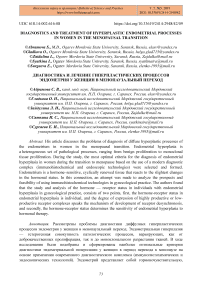Diagnostics and treatment of hyperplastic endometrial processes in women in the menopausal transition
Автор: Abramova Svetlana, Gladkova Olga, Zaidulina Lilia, Syatkina Irina, Surgaeva Elena
Журнал: Бюллетень науки и практики @bulletennauki
Рубрика: Медицинские науки
Статья в выпуске: 5 т.5, 2019 года.
Бесплатный доступ
His article discusses the problems of diagnosis of diffuse hyperplastic processes of the endometrium in women in the menopausal transition. Endometrial hyperplasia is a heterogeneous set of pathological processes, ranging from benign proliferation to monoclonal tissue proliferation. During the study, the most optimal criteria for the diagnosis of endometrial hyperplasia in women during the transition to menopause based on the use of a modern diagnostic complex (immunohistochemical and endoscopic technologies) were selected and formed. Endometrium is a hormone-sensitive, cyclically renewed tissue that reacts to the slightest changes in the hormonal status. In this connection, an attempt was made to analyze the prospects and feasibility of using immunohistochemical technologies in gynecological practice. The authors found that the study and analysis of the hormone - receptor status in individuals with endometrial hyperplasia in gynecological practice, consists of two points, first, the hormone-receptor status in endometrial hyperplasia is individual, and the degree of expression of highly productive or low-productive receptor complexes speaks the mechanism of development of receptor desynchronosis, and secondly, the hormone-receptor status determines the sensitivity of endometrial hyperplasia to hormonal therapy.
Endometrial hyperplastic processes, diagnostics and optimization of treatment
Короткий адрес: https://sciup.org/14115491
IDR: 14115491 | УДК: 618.14-002:616-08 | DOI: 10.33619/2414-2948/42/09
Список литературы Diagnostics and treatment of hyperplastic endometrial processes in women in the menopausal transition
- Cooper N. A. M., Clark T. J. Ambulatory hysteroscopy // The obstetrician & gynaecologist. 2013. V. 15. №3. P. 159-166. DOI: 10.1111/tog.12039
- Jacobs I. et al. Sensitivity of transvaginal ultrasound screening for endometrial cancer in postmenopausal women: a case-control study within the UKCTOCS cohort // The lancet oncology. 2011. V. 12. №1. P. 38-48. (10)70268-0. DOI: 10.1016/S1470-2045
- Abu Hashim H. et al. LNG-IUS treatment of non-atypical endometrial hyperplasia in perimenopausal women: a randomized controlled trial // Journal of gynecologic oncology. 2013. V. 24. №2. P. 128-134. DOI: 10.3802/jgo.2013.24.2.128
- Behnamfar F., Ghahiri A., Tavakoli M. Levonorgestrel-releasing intrauterine system (Mirena) in compare to medroxyprogesterone acetate as a therapy for endometrial hyperplasia // Journal of research in medical sciences: the official journal of Isfahan University of Medical Sciences. 2014. V. 19. №8. P. 686. DOI: 10.3390/healthcare5030030
- Zaino R. et al. Tumours of the uterine corpus: epithelial tumours and precursors // WHO classification of tumours of the female reproductive organs. 2014. V. 4. P. 125-34.
- Emons G. et al. New WHO classification of endometrial hyperplasias // Geburtshilfe und Frauenheilkunde. 2015. V. 75. №02. P. 135-136.
- Gallos I. D., et al. Management of Endometrial Hyperplasia // Green-top Guideline. 2016. №67.


